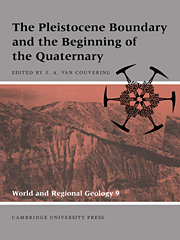Book contents
- Frontmatter
- Contents
- List of contributors
- Preface: the new Pleistocene
- Foreword
- Part I Definition of the base of the Quaternary
- Part II Characterization of the Pleistocene boundary-stratotype
- 2 The Pliocene–Pleistocene boundary-stratotype at Vrica, Italy
- 3 The magnetostratigraphy of the Vrica section, Italy, and its correlation with the Plio–Pleistocene of the Boso Peninsula, Japan
- 4 Comparison of the laminated units at Vrica and deep-sea sapropels from the eastern Mediterranean
- 5 Calcareous nannofossil biochronology and the Pliocene–Pleistocene boundary
- 6 Diatom microfossils from the Vrica section
- Part III The paleontological context of the Pleistocene boundary
- Part IV The Pleistocene boundary in regional sequences
- Index
2 - The Pliocene–Pleistocene boundary-stratotype at Vrica, Italy
Published online by Cambridge University Press: 10 November 2009
- Frontmatter
- Contents
- List of contributors
- Preface: the new Pleistocene
- Foreword
- Part I Definition of the base of the Quaternary
- Part II Characterization of the Pleistocene boundary-stratotype
- 2 The Pliocene–Pleistocene boundary-stratotype at Vrica, Italy
- 3 The magnetostratigraphy of the Vrica section, Italy, and its correlation with the Plio–Pleistocene of the Boso Peninsula, Japan
- 4 Comparison of the laminated units at Vrica and deep-sea sapropels from the eastern Mediterranean
- 5 Calcareous nannofossil biochronology and the Pliocene–Pleistocene boundary
- 6 Diatom microfossils from the Vrica section
- Part III The paleontological context of the Pleistocene boundary
- Part IV The Pleistocene boundary in regional sequences
- Index
Summary
Introduction
The Plio–Pleistocene sequence of deep-water marine beds at Vrica, Calabria, Italy, was proposed by INQUA Subcommission 1-d, “Pliocene/Pleistocene Boundary,” and by the working group of IGCP Project 41, “Neogene/Quaternary Boundary,” as the location for a physical boundary-stratotype for the base of the Pleistocene, according to modern chronostratigraphic guidelines. The recommended level has been adopted formally by the IUGS (Nikiforova and Alekseev, Chapter 1, this volume). That section is herein characterized in terms of sedimentology, paleoecology, biostratigraphy, biochronology, and magnetostratigraphy, based on a decade of studies by stratigraphers in different countries. According to criteria established by prior recommendations, the physical location of the Pleistocene boundary-stratotype is identified with the base of the claystone conformably overlying marker bed e of the Vrica section. This level is very close to the Olduvai normal-polarity subzone and is approximately coeval with the beginning of a cold-climate phase marked by the first appearance of the “northern guest” Arctica islandica, a mollusk confined to boreal waters during interglacial periods.
Background
At the XVIII International Geological Congress in London in 1948, the council unanimously accepted the recommendation of the temporary commission to advise on the question of the definition of the Pliocene–Pleistocene boundary, which made the following essential points: “The Commission considers that the Pliocene–Pleistocene boundary should be based on changes in marine faunas…. The classic area of marine sedimentation in Italy is regarded as the area where this principle can be implemented best” (King and Oakley, 1950).
- Type
- Chapter
- Information
- Publisher: Cambridge University PressPrint publication year: 1996
- 5
- Cited by



